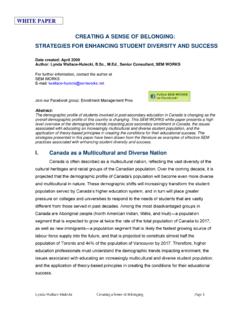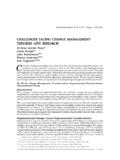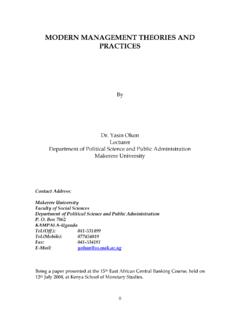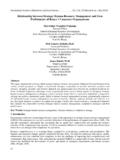Transcription of REFRAMING STRATEGIC ENROLLMENT MANAGEMENT …
1 _____ REFRAMING STRATEGIC ENROLLMENT MANAGEMENT FROM THE ACADEMIC LENS: THEORY IN PRACTICE (PART 2) Date created: February 2009 Author: Lynda Wallace-Hulecki, Senior Consultant, SEM WORKS For further information, contact the author at SEM WORKS, 407 Pebble Ridge Court, Greensboro, NC 27455. Web: . E-mail: This article is the second in a series of papers based upon a 2007 study that was designed to develop a deeper understanding of the processes and procedures for success in building shared responsibility for ENROLLMENT outcomes with the academic community. This second paper provides practical tips for the chief ENROLLMENT manager in the application of the SEM theories that were substantiated in the research.
2 Introduction A fundamental tenet underlying the success of STRATEGIC ENROLLMENT MANAGEMENT (SEM) initiatives is the ability of institutions to adopt ENROLLMENT MANAGEMENT as a shared responsibility that is rooted within the academic ethos. However, SEM practitioners frequently site tensions between the academic-driven culture of institutions and the student-centered culture that underlies effective SEM practice. In the first of this series of articles, I described a 2007 study that was designed to develop a deeper understanding of the processes and procedures for success in building shared responsibility for ENROLLMENT outcomes with the academic community. In this second paper, I provide a synopsis of the SEM theories substantiated in the 2007 study, as well as practical tips for the application of the theory in practice.
3 I. Overview of the 2007 Study Results The first article presented the results from a study involving a purposeful sample of five SEM practitioners who were reputed for effecting positive change by actively engaging the academic community in the SEM process. The results from this study substantiated many of the fundamental tenets underlying SEM-related theories, which are summarized below: SEM AS A PROCESS SEM as a Component of STRATEGIC Planning The study substantiated that SEM is inherently goal-oriented and often takes one of four planning orientations as defined by Kalsbeek (2006) academic, administrative, market-centered, and/or student-focused. In all cases presented by the study participants, the objectives underlying the SEM process reflected an academic orientation where the primary outcomes and measures of the planning process focused on the student profile, student preparedness, progress, and outcomes.
4 However, other factors related to market positioning and/or An institution s academic program is inexorably codependent on its ENROLLMENT MANAGEMENT . The quality of academic programs can only be developed and maintained in a stable ENROLLMENT environment, and stable enrollments are only possible through sound planning, development, and MANAGEMENT of academic programs. (Dolence, 1997) Not all STRATEGIC plans address ENROLLMENT MANAGEMENT , but ENROLLMENT MANAGEMENT cannot work without STRATEGIC planning. (Massa, 2001) balancing revenue, prestige, and access were also important, and in some cases appeared to be more significant, depending on the institutional objectives at hand. The Importance of Visible Leadership by the Provost and President The study substantiated the assertions of Dolence (1993, 1997), Henderson (2004), and others of the importance of actively engaging the academic community in the SEM planning process, and of the need for visible leadership of the President and Chief Academic Officer in linking the importance of SEM to the academic well-being of the institution.
5 SEM AS A DRIVER OF CHANGE A Compelling Reason for Change Consistent with change theory as articulated by Hossler (1990), and subsequently by Kotter (1995) and Owen (2001), an ENROLLMENT and/or an ENROLLMENT -related financial crisis was the catalyst for change in all situations. It was the connection between ENROLLMENT and institutional budget, and the relationship between ENROLLMENT and the institution s national ranking (a quasi indicator for market positioning) that created the sense of urgency. Grounded in Research and Data: The Language of Academics A recurrent strategy employed in the SEM planning process was the consistent use of research and data to communicate the need for change a strategy Henderson (2004) associated with the ability of ENROLLMENT professionals to speak the language of the academic.
6 Linked to the Academic Context When queried about how the academic character and values of the institution had changed as a result of the SEM planning process, the following impacts were most frequently cited and in large measure, were consistent with Henderson s (2004) characterization of organizations with an EM ethos centered within the academic context. Specifically, the study participants referenced: If ENROLLMENT MANAGEMENT starts with institutional mission, it ultimately succeeds or fails based on the strength of its link to academics and student success. (Bontrager, 2004) a heightened level of understanding and involvement of the institutions, particularly among academic deans and faculty, in achieving ENROLLMENT goals; an enhanced focus on longer-term STRATEGIC planning; a greater reliance on research and data; and and a stronger orientation and attention to key performance metrics.
7 IMPORTANCE OF STRUCTURE The Importance of ENROLLMENT Planning Structures Although the mechanisms used for institutional discussion were less formal than suggested by many theoretical constructs, the Deans Council and/or an ENROLLMENT Planning Committee comprised of senior academic leaders and influencers tended to be the focal point(s) for STRATEGIC discussions on the ENROLLMENT challenges facing the institution and the STRATEGIC opportunities at hand. These structures were deemed to enhance participation, collaboration, and consultation within the academic enterprise. The Importance of Engaging Academic Leaders at the Level of the Dean at Critical Decision Points Most frequently, Deans were involved in three of Bryson s (2004) ten STRATEGIC planning stages.
8 Identifying the organization s mandate and need for change Identifying SEM issues and policy implications Decisions on what SEM strategies to adopt Deans were also most often engaged in four of the eight steps articulated by Kotter (1995) and Owen (2001) in introducing transformative change, these being in communicating a sense of urgency, in formulating a vision for the future, in forming a powerful coalition with key influencers in the process, and in institutionalizing new approaches to ENROLLMENT planning and MANAGEMENT . The Use of Incentives Tied to Accountability Study participants noted that incentives were used to leverage the engagement of academic Deans. ENROLLMENT goals tied to financial incentives with accountability for outcomes were often a point ENROLLMENT structure follows academic understanding, and therein lies the future of ENROLLMENT MANAGEMENT .
9 (Henderson, 2004) of negotiation between the Chief Academic Officer and individual Deans, in consultation with the Chief ENROLLMENT Manager. Lateral and Horizontal Communication Structures to Extend the Discussions into the Academic Units In relation to the involvement of the faculty-at-large, the primary mechanisms cited were through governance bodies as well as through cascading discussion processes flowing from those at the Deans Council level through to the academic units. An underlying success factor was that there was a willingness among the academic community to consider change. ROLE OF THE CHIEF ENROLLMENT MANAGER (CEM) CEMs are Systems Thinkers Adept at Influencing Change Study participants confirmed that the types of roles served by the CEMs in the ENROLLMENT planning process were similar to those articulated by Jim Black (2003a, 2003b, 2003c, 2003d) in applying Bolman and Deals (1991) four dimensions of change for REFRAMING organizations to the future EM reflected that the CEMs roles were to communicate through evidence-based research and data the urgency behind the call to action, and that they did so through communicating both laterally and horizontally.
10 The CEMs served as collaborators in working with the Chief Academic Officer, and as a resource to the Deans in extending the dialogue into the academic units for purposes of formulating ENROLLMENT strategies. Among the most salient advice provided by the study participants for the role of the Chief ENROLLMENT Manager was the need to become, what Henderson (2004) referred to as being a student of institutional culture. II. Practical Tips for Applying the Theory in Practice While many institutions subscribe to the theory-based concepts, few have actually embodied them actively and intentionally. This section presents practical tips for the application of the theory, based upon the sage perspectives of the five SEM study participants, as well as based upon my own experiences as a SEM leader/practitioner with more than thirty years experience within both a college and a university environment.








